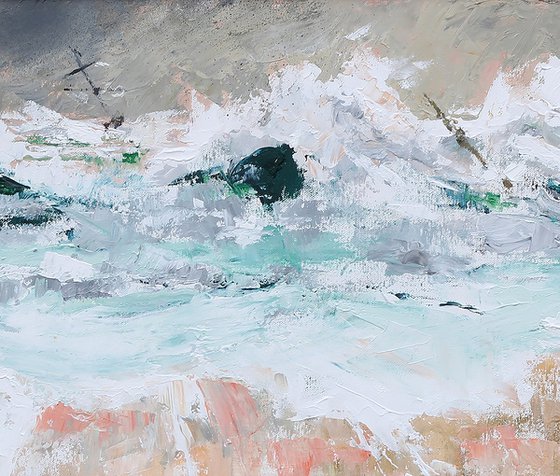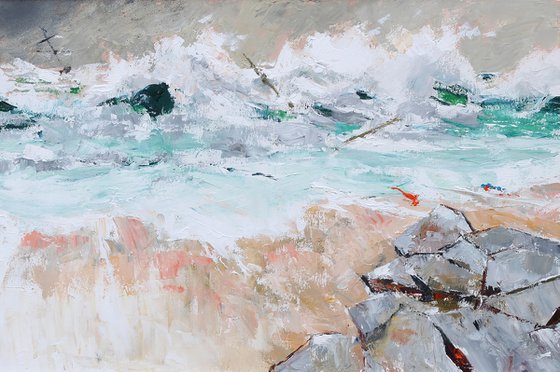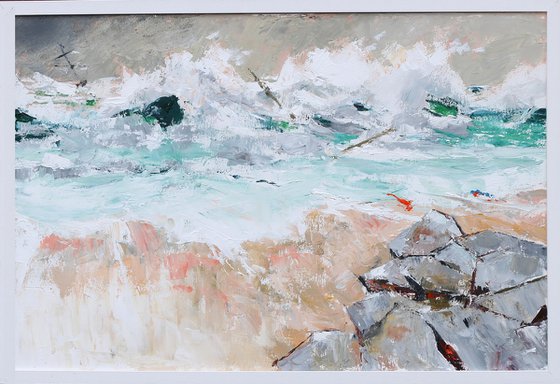Main Navigation
Original artwork description:
On the second of February 1687 the Swedish barque Freida rounded Start Point about two miles to the South. The wind was a fresh Easterly and the captain was planning to thread his way between the North Isles and be in the shelter of Kirkwall by nightfall. The sky had an ominous yellow tinge with a dark line at the horizon presaging an increase in the wind. Within twenty minutes the wind duly arrived and veered violently through SE ending in due South. By this time they had passed Lopness and could no longer turn into the North Ronaldsay sound to pick up shelter in Otterswick. As the ship crabbed sideways across Newark Bay it was clear that they couldn’t wear Tressness point on Sanday’s East shore. The 20′ ships tender was launched, tow lines attached in an effort to keep the track of the boat with enough southward momentum. It became quickly apparent that this was not going to work and the captain took the uneasy decision to try anchoring and attempt to ride out the gale. An hour later as the wind increased to storm force the port cable snapped followed shortly by the starboard one. Within 20 minutes the ships keel grounded on the outer fringe of the Ba’ and swung the ship broadside to he weather. As the boat listed the order was given to cut the stays and halyards and allow the masts and rigging to fall over the lee side and abandon ship. Overnight as some of the crew made landfall the wind reached hurricane strength breaking the hull into fragments.
All right, I made the last bit up ….but who knows? Centuries later a large section was exposed by wave action and the puzzle of the Sanday wreck began, giving amateur sleuths, local historians, dendrochronologists, marine archaeologists, metal tank manufacturers, heritage gurus and hundreds of others with Facebook pages to pass judgement…the jury’s still out…so maybe I got some of it right.
Materials used:
Oils on triple primed canvas
Tags:
#seascape #waves #wreck #gales #orkney wreckDeath of a Ship (2025) Oil painting
by Bill McArthur
23 Artist Reviews
£1,250
- Oil painting on Canvas
- One of a kind artwork
- Size: 58 x 38 x 2.5cm (framed) / 52 x 36cm (actual image size)
- Framed and ready to hang
- Signed on the back
- Style: Impressionistic
- Subject: Landscapes, sea and sky
Loading
Original artwork description
On the second of February 1687 the Swedish barque Freida rounded Start Point about two miles to the South. The wind was a fresh Easterly and the captain was planning to thread his way between the North Isles and be in the shelter of Kirkwall by nightfall. The sky had an ominous yellow tinge with a dark line at the horizon presaging an increase in the wind. Within twenty minutes the wind duly arrived and veered violently through SE ending in due South. By this time they had passed Lopness and could no longer turn into the North Ronaldsay sound to pick up shelter in Otterswick. As the ship crabbed sideways across Newark Bay it was clear that they couldn’t wear Tressness point on Sanday’s East shore. The 20′ ships tender was launched, tow lines attached in an effort to keep the track of the boat with enough southward momentum. It became quickly apparent that this was not going to work and the captain took the uneasy decision to try anchoring and attempt to ride out the gale. An hour later as the wind increased to storm force the port cable snapped followed shortly by the starboard one. Within 20 minutes the ships keel grounded on the outer fringe of the Ba’ and swung the ship broadside to he weather. As the boat listed the order was given to cut the stays and halyards and allow the masts and rigging to fall over the lee side and abandon ship. Overnight as some of the crew made landfall the wind reached hurricane strength breaking the hull into fragments.
All right, I made the last bit up ….but who knows? Centuries later a large section was exposed by wave action and the puzzle of the Sanday wreck began, giving amateur sleuths, local historians, dendrochronologists, marine archaeologists, metal tank manufacturers, heritage gurus and hundreds of others with Facebook pages to pass judgement…the jury’s still out…so maybe I got some of it right.
Materials used:
Oils on triple primed canvas
Tags:
#seascape #waves #wreck #gales #orkney wreck14 day money back guaranteeLearn more




